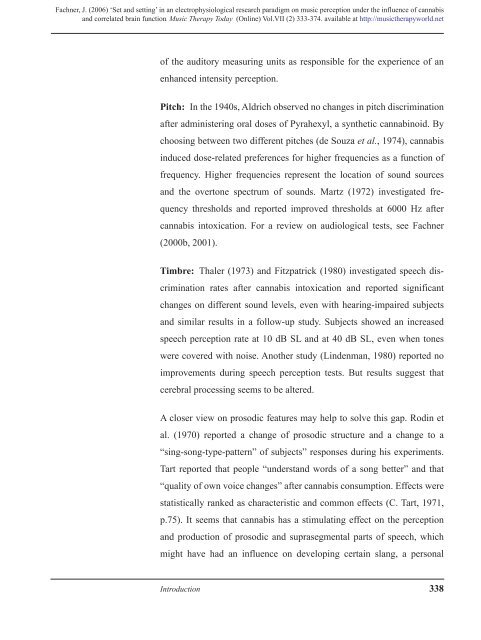Music Therapy Today - World Federation of Music Therapy
Music Therapy Today - World Federation of Music Therapy
Music Therapy Today - World Federation of Music Therapy
You also want an ePaper? Increase the reach of your titles
YUMPU automatically turns print PDFs into web optimized ePapers that Google loves.
Fachner, J. (2006) ‘Set and setting’ in an electrophysiological research paradigm on music perception under the influence <strong>of</strong> cannabis<br />
and correlated brain function. <strong>Music</strong> <strong>Therapy</strong> <strong>Today</strong> (Online) Vol.VII (2) 333-374. available at http://musictherapyworld.net<br />
<strong>of</strong> the auditory measuring units as responsible for the experience <strong>of</strong> an<br />
enhanced intensity perception.<br />
Pitch: In the 1940s, Aldrich observed no changes in pitch discrimination<br />
after administering oral doses <strong>of</strong> Pyrahexyl, a synthetic cannabinoid. By<br />
choosing between two different pitches (de Souza et al., 1974), cannabis<br />
induced dose-related preferences for higher frequencies as a function <strong>of</strong><br />
frequency. Higher frequencies represent the location <strong>of</strong> sound sources<br />
and the overtone spectrum <strong>of</strong> sounds. Martz (1972) investigated fre-<br />
quency thresholds and reported improved thresholds at 6000 Hz after<br />
cannabis intoxication. For a review on audiological tests, see Fachner<br />
(2000b, 2001).<br />
Timbre: Thaler (1973) and Fitzpatrick (1980) investigated speech dis-<br />
crimination rates after cannabis intoxication and reported significant<br />
changes on different sound levels, even with hearing-impaired subjects<br />
and similar results in a follow-up study. Subjects showed an increased<br />
speech perception rate at 10 dB SL and at 40 dB SL, even when tones<br />
were covered with noise. Another study (Lindenman, 1980) reported no<br />
improvements during speech perception tests. But results suggest that<br />
cerebral processing seems to be altered.<br />
A closer view on prosodic features may help to solve this gap. Rodin et<br />
al. (1970) reported a change <strong>of</strong> prosodic structure and a change to a<br />
“sing-song-type-pattern” <strong>of</strong> subjects” responses during his experiments.<br />
Tart reported that people “understand words <strong>of</strong> a song better” and that<br />
“quality <strong>of</strong> own voice changes” after cannabis consumption. Effects were<br />
statistically ranked as characteristic and common effects (C. Tart, 1971,<br />
p.75). It seems that cannabis has a stimulating effect on the perception<br />
and production <strong>of</strong> prosodic and suprasegmental parts <strong>of</strong> speech, which<br />
might have had an influence on developing certain slang, a personal<br />
Introduction 338

















